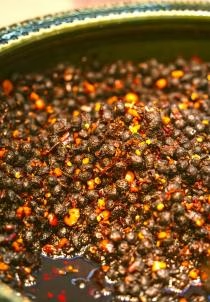Using fermented black beans, you can instantly create dishes like oysters with fermented black beans, simmered black bean heads, and spareribs with fermented black beans. With its salty, fragrant flavor, fermented black beans are a traditional Hakka delicacy, perpetuating the Hakka people’s love of food. What kind of beans are black fermented black beans? How are they made? Everything you need to know about fermented black beans
The secret to fermented black beans’ wondrous flavor
Each bean has a slightly pungent, fermented aroma before cooking, but once cooked, it becomes a delicious and delicious dish.
Fermented black beans (or soybeans) are made through a process of soaking, steaming, fermenting, drying, and then salting. The fermentation process and the infusion of salt, sugar, and wine give the fermented black beans their fragrant aroma.
Fermented black beans are particularly iconic in the Hakka culture. Hakka people, known for their ability to preserve and cherish food, developed a recipe to preserve black beans for a longer period of time.
Fermented black beans can be made from either yellow or black beans. During the steaming and sun-drying process, aromatic amino acids undergo oxidation, enhancing their color and flavor. This contributes to the delicate flavor of the dish.
Fermented black beans are flavored through ancient methods and specialized fermentation techniques.
Traditionally, fermented black beans were prepared by covering the beans with straw or leaves. Modern fermentation rooms utilize specialized fermentation spaces and koji-making techniques to systematically control temperature and fermentation speed, ensuring a controlled production process.
Fermented black beans are generally categorized as wet or dry. After salting, dry black beans are then sun-dried or air-dried to remove moisture, making them easier to preserve than wet varieties.
While tempeh is delicious, it’s important to keep an eye on sodium intake.
Because tempeh is soaked and salted in a high-salt environment, it not only has a strong salty flavor, but also has a high sodium content, exceeding 6,000 mg per 100 grams. As you can imagine, just a few tempeh granules and a small amount of their liquid are sufficient to contribute to the saltiness and sodium content of the dish.
Despite the significant sodium content, as a soy product, it still provides excellent nutrients like protein, potassium, and phosphorus. However, considering the overall effect, it’s best to consume it in moderation with each meal.
For those seeking a protein boost from soy, consider combining a small amount of tempeh with edamame, green beans, or dried tofu.
Two Recommended Salty and Fragrant Fermented Black Bean Dishes
The strong flavor of fermented black beans enriches the flavor and masks fishy odors, making them particularly suitable for seafood, meat, or vegetables with strong bitter or other flavors. Common cooking methods include stir-frying and steaming:
- Stir-frying:
- Soak the dried fermented black beans first to soften them and reduce the saltiness.
- Stir-frying allows the fermented black bean flavor to quickly envelop the ingredients, eliminating the need for additional salt and masking any fishy flavor. Typical dishes include oysters with fermented black beans, oyster heads, and stir-fried dried tofu with fermented black beans.
- Spring and summer oysters are more plump than winter. Stir-fry diced tofu with scallion whites and greens, soy sauce, fermented black beans, and rice wine. Finally, add the previously blanched oysters to preserve their tenderness. The fermented black beans effectively suppress the fishy flavor, eliminating the risk of a nasty, fishy taste.
- When using dried fermented black beans, soak them in water or rice wine first to remove the saltiness and beany smell, softening them and making them easier to cook.
- Fermented black beans are also very effective when stir-fried with small dried fish, sliced meat, carrots, green peppers, and bean sprouts—all of which are easily smelly. If you have picky eaters at home, using fermented black beans can be a great way to enhance the flavor of your dishes.
- Steaming and Braising:
- Cooking fermented black beans with the sauce adds a richer flavor.
- If you’re tired of steaming fish or seafood plain, try steamed fermented black beans as a side dish with rice or alcohol. A few grains of fermented black beans and fermented black bean sauce, combined with a pinch of shredded ginger, can elevate the flavor of seafood, making it a hassle-free way to steam fish fillets in a rice cooker.
- Or, steamed spare ribs with fermented black beans, marinated with soy sauce, rice wine, fermented black beans, and chopped green onions, are a favorite for both adults and children.
- For those who can tolerate bitterness, braised pork with fermented black beans and bitter melon is a must-try home-cooked dish. The bitter melon’s bitterness is tempered by the fermented black beans, which transform it into a bitter-salty yet sweet flavor.
- Those who can tolerate a slight bitterness will appreciate the subtle blend of bitterness and savory flavor, making the dish even more palatable the more they eat it.
- When using fermented black beans in steamed and braised dishes, the flavor is more pronounced during the braising process, and adding a little fermented black bean juice can reduce the need for additional soy sauce and salt.
Fermented black beans are commonly stored in cans or bags. Use a clean, dry spoon to scoop out the food and seal it tightly in the refrigerator immediately after use. Proper storage to prevent moisture from entering will ensure mold and ensure a safer diet.


Leave a Reply